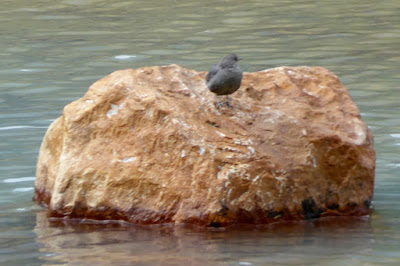Joan and I had signed up for the late (4:00 pm) bus, snaring us another hiking day. We took the East Opabin trail up to the Opabin Plateau, a change from our other hike there. On the way we saw some birds on the O'Hara lakeshore.
Before embarking on the east trail we looked back to the bluff formation we've nicknamed "lunch rock."
After the forested switchbacks of the east trail we took a staircased connector to the Cascade Lakes. We were breaking trail through the snow, except for animal tracks.
At the lakes we saw ducks and an american dipper, adapted and oblivious to the frigid water.
Another shot of mountains, lakes, and ice.
We continued on the West Opabin trail and headed towards Opabin Lake, skirting the edge of Hungabee Lake.
 |
| Looking east towards the Yukness Ledges. |
 |
| Hungabee Lake -- almost a black and white photo! |
We descended to the other side of Hungabee,
 |
| The track at right is the East Opabin trail. |
Out to the Opabin Prospect, where Lake O'Hara played peek-a-boo.
After our crisscrossing of the plateau we headed down the West Opabin trail, and some precipitation began. It picked up as we chatted with a Parks Canada warden on the O'Hara lakeshore. It was time to go into the lodge and warm up with the fire and afternoon tea, followed by the bus ride down to the parking area, where I brushed snow off our rental car by hand.
We were on our way to Moraine Lake Lodge, which wasn't far, and where we would spend the next three nights. However, the explosive popularity of Lake Louise and Moraine Lake presented obstacles.
But according to the literature/e-mail from Moraine Lake Lodge, as lodge guests with proof via printout, we should have been allowed to make the left hand turn. The barrier dude explained that his supervisor told him that nobody turned left, but he thought it was a stupid rule and since Joan and I had already turned in that direction to talk to him, we might as well go ahead. What about next time? we asked. "Give it a go," he said, shrugging.
We squeezed the Corolla into the last parking space at the lodge. We were staying in one of the cabins -- outlying structures fancier than the term "cabin" implies -- and ours was at the far end.
After dinner we chewed over our options for tomorrow's hiking; the weather forecast was not enticing. Joan and I decided on Paradise Valley and then we collapsed into bed.






































































